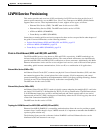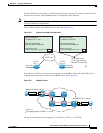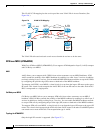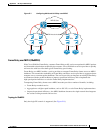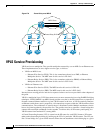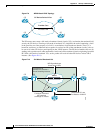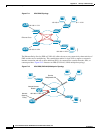
E-13
Cisco IP Solution Center L2VPN and Carrier Ethernet User Guide, 6.0
OL-21636-01
Appendix E ISC Layer 2 VPN Concepts
VPLS Service Provisioning
VPLS for an Ethernet-Based (L2) Provider Core
With an Ethernet-based provider core, customer traffic forwarding is trivial in the core. VPLS for an
Ethernet-based provider core is a multipoint Layer 2 VPN that connects two or more customer devices
using 802.1Q-in-Q tag-stacking technology. A VPLS essentially emulates an Ethernet switch from a
users perspective. All connections are peers within the VPLS and have direct communications. The
architecture is actually that of a distributed switch.
For more information on VPLS for an Ethernet-based provided core, see the following sections:
• Multipoint EWS (EP-LAN) for an Ethernet-Based Provider Core, page E-13
• Multipoint ERS (EVP-LAN) for an Ethernet-Based Provider Core, page E-13
• Topology for Ethernet-Based VPLS, page E-13
Multipoint EWS (EP-LAN) for an Ethernet-Based Provider Core
Multipoint EWS (also known as EP-LAN in MEF terminology) is a service that emulates a point-to-point
Ethernet segment. The EWS service encapsulates all frames that are received on a particular User to
Network Interface (UNI) and transports these frames to a single egress UNI without reference to the
contents contained within the frame. This service operation means that EWS can be used for untagged
or VLAN tagged frames and that the service is transparent to all frames offered. Because the EWS
service is unaware that VLAN tags might be present within the customer frames, the service employs a
concept of “All to One” bundling.
Multipoint ERS (EVP-LAN) for an Ethernet-Based Provider Core
Multipoint ERS (also known as EVP-LAN in MEF terminology) models the connectivity offered by
existing Frame Relay networks by using VLAN indices to identify virtual circuits between sites. ERS
does, however, offer a far greater degree of QoS functionality depending upon the service provider's
implementation and the customer's acceptance of VLAN indices that are administratively controlled by
the service provider. Additionally, ERS service multiplexing capability offers lower cost of ownership
for the enterprise as a single interface can support many virtual interfaces.
Topology for Ethernet-Based VPLS
Ethernet-based VPLS differs from the point-to-point L2VPN definitions of EWS (EP-LAN) and ERS
(EVP-LAN) by providing a multipoint connectivity model. The VPLS service does not map an interface
or VLAN to a specific point-to-point pseudowire, but instead it models the operation of a virtual Ethernet
switch. VPLS uses the customer’s MAC address to forward frames to the correct egress UNI within the
service provider’s network for the EWS (EP-LAN).
The EWS (EP-LAN) service emulates the service attributes of an Ethernet switch and learns source MAC
to interface associations, flooding unknown broadcast and multicast frames.
Figure E-11 illustrates an
EWS (EP-LAN) VPLS topology.



